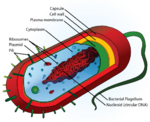|
|
Introduction
One of the main causes of disease is infection by microorganisms, with four types so far identified:
- Viruses
- Bacteria
- Fungi
- Parasites- comprising protozoa and helminths
All exist as either:
- Primary pathogens (obligate): presence always corresponds with disease
- Secondary (opportunistic): prerequisites must be fulfilled before disease occurs
Microorganisms can enter the body by three routes:
- Contact: typically seen in dermatological infections
- Aerosol: typically respiratory infections
- Orofecal:typically enteric infections
Viruses
Bacteria
Structure
Bacteria offer the immune system a greater range of foreign components with which to be recognized, including:
- Flagellum
- Pili
- Capsule
- Cellular components: membrane, cell sap containing enzymes, genetic material, cell wall
Pathogenesis
Bacterial invasion can be either:
- Localized, such as an abscess
- Systemic, such as septicemia
Some bacteria also produce toxins:
- Endotoxogenic: cell wall degradation products (lipopolysaccharide) released into the blood stream, causing toxic shock
- Exotoxogenic: bacteria produce and secrete toxin (such as tetanus and botulism)
Replication
The lifespan of bacteria differs from that of viruses in that it includes a colonization phase, which occurs on epithelial surfaces. As bacteria are capable of self-replication (i.e. they don't require host cellular machinery), this colonization phase allows them to develop a highly skilled and lethal army before invading the body. Once invasion occurs, spread can occur via the vascular or lymphatic systems. The pathogenesis of a particular strain of bacteria very much depends upon its location in the body: "Streptococcus pneumoniae in the lung causes pneumonia...whereas in the blood it causes a rapidly fatal systemic illness, pneumoncoccal sepsis." (Murphy, et al, 43)
Immunity to Bacteria
- Bacterial evasion of immunity
- Bacterial capsules can avoid phagocytosis and complement activation
- Some bacteria are able to survive phagocytosis and evade digestion (such as mycobacterium and Leptospira)
- Innate Immunity to Bacteria
- Adaptive Immunity to Bacteria:
Phagocytosis and digestion are the primary tools of the Immune System to conquering bacterial infection. These are enhanced by the production of IgG and CD8+ Tcells, as well as by complement activation.
Prevention and control
Antibiotics can be used to prevent and control bacterial invasion, replication, and dissemination.
Parasites
Types
Parasites broadly include:
- Helminths (worms)
- Arthropods (insects)
- Protozoa (single-celled eukaryotes)
Immunity to Parasites
The immune system relies on granulocytes (mast cells and eosinophils) and the production of IgE antibody to combat parasitic infection. Once produced in response to danger signals, IgE attaches to circulating granulocytes. IgE then binds to the parasite, signals mast cell and eosinophil degranulation, and causes enzymatic digestion of the intruder.
References
- Murphy, K., Travers, P. and Walport, M. (2008) Janeway's Immunobiology. 7th ed. New York: Garland Science Publishing.
